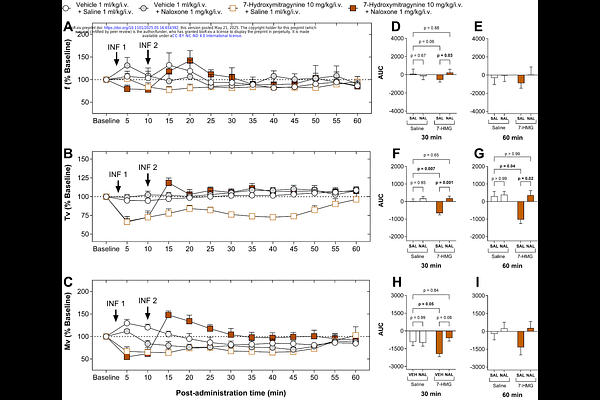Mitragynine and 7-Hydroxymitragynine: Bidirectional Effects on Breathing in Rats

Mitragynine and 7-Hydroxymitragynine: Bidirectional Effects on Breathing in Rats
Zuarth Gonzalez, J. D.; Ragsdale, A. K.; Mukhopadhyay, S.; McCurdy, C. R.; McMahon, L. R.; Obeng, S.; Wilkerson, J. L.
AbstractThe use of kratom as an alternative to conventional opioids has surged, driven largely by anecdotal reports of its efficacy for pain relief and opioid withdrawal management. The growing prevalence of kratom products enriched with 7-hydroxymitragynine (7-HMG), an active metabolite of mitragynine (MG), necessitates evaluating the respiratory effects of these alkaloids and determining if naloxone reverses their potential respiratory depressant effects. Respiratory parameters were measured in awake, freely moving female and male Sprague-Dawley rats using whole body plethysmography. To minimize handling-induced artifacts and ensure precise respiratory recordings, drugs were administered intravenously. Morphine and 7-HMG induced significant respiratory depression, evidenced by reductions in breathing frequency, tidal volume, and minute volume. In contrast, MG administration unexpectedly increased respiratory frequency. Naloxone fully reversed the respiratory depression induced by both morphine and 7-HMG but did not alter the respiratory stimulant effects produced by MG. These findings demonstrate that 7-HMG exhibits significant respiratory depressant properties similar to classical opioids, and importantly, such depressant effects are effectively antagonized by naloxone. Conversely, MG exerts respiratory stimulant effects through mechanisms independent of opioid receptor pathways. Collectively, these data highlight crucial pharmacological distinctions between kratom alkaloids, underscoring the risk associated with high 7-HMG-containing kratom products and suggesting that the predominant alkaloid MG may offer a safer respiratory profile.